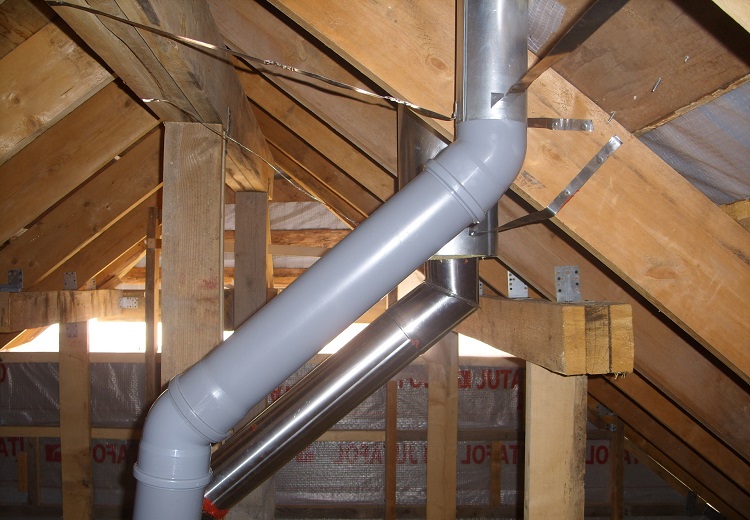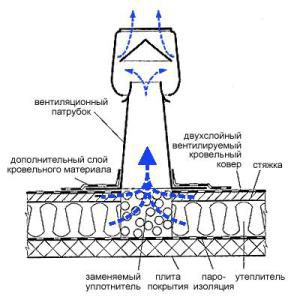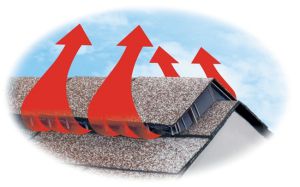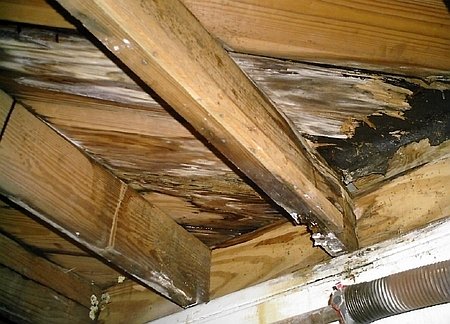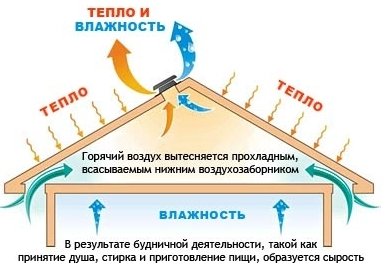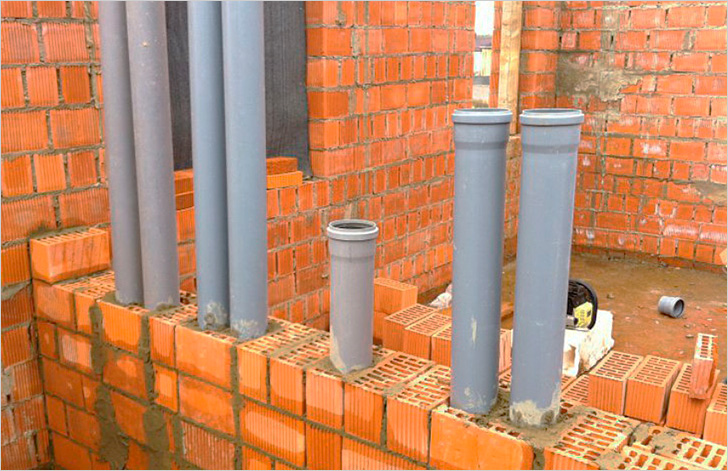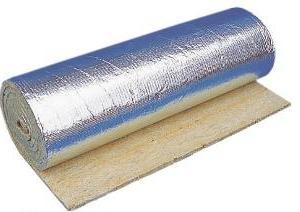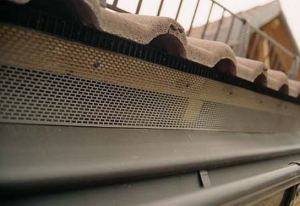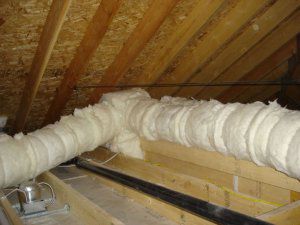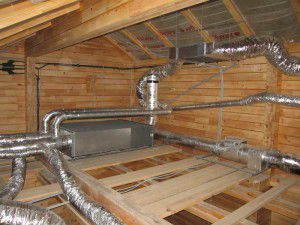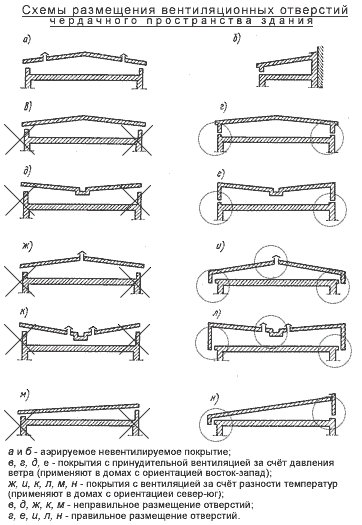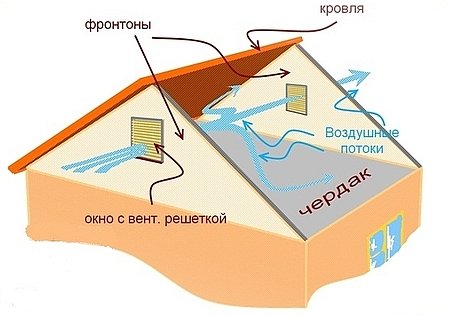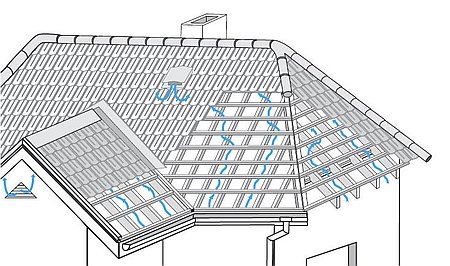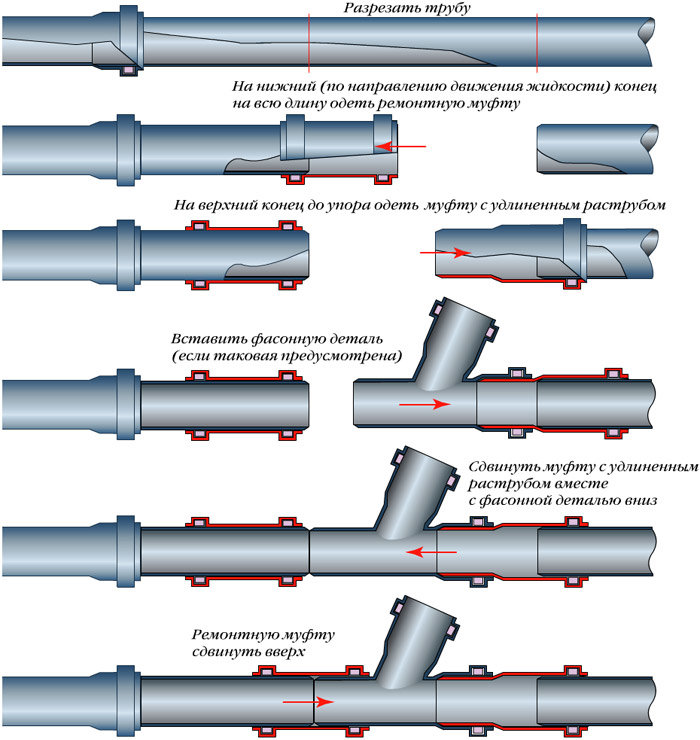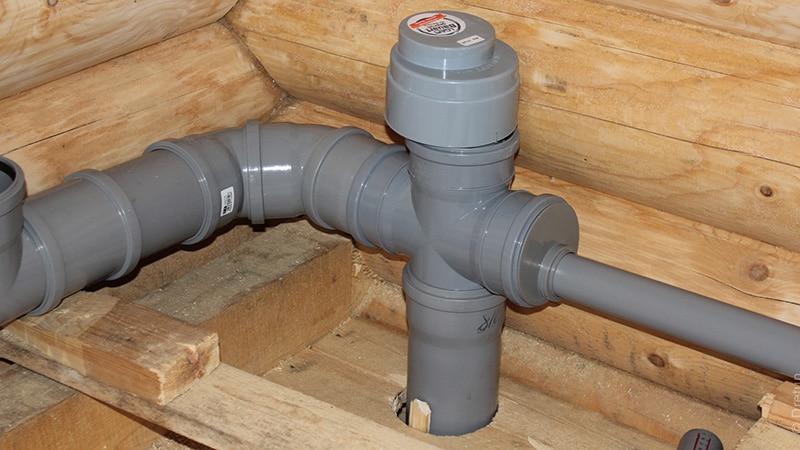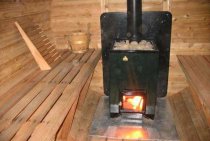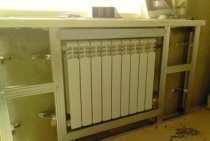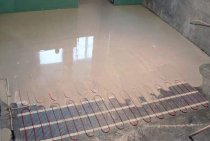The value of pipes for the ventilation system
The ventilation duct of PVC sewer pipes can have any bend shape
In the process of air exchange, about 30 cubic meters of fresh air should be supplied to each citizen living in this living space. The ventilation system must provide it. Pipes are the arteries of a complex ventilation mechanism. According to them, from the most polluted premises (toilet, kitchen, bathroom, workshop, etc.), vapors, gases, odors are removed. In "prosperous" rooms (bedroom, living room, etc.) - served.
When organizing natural ventilation in areas with the formation of pollution, vertical channels are mounted for air movement with an outlet to the roof. Through them, the stale air flow escapes into the atmosphere at a considerable height: the higher the nozzle, the more effective the thrust. Log cabins and frame buildings, as well as buildings where ventilation was not provided at the design stage, are equipped with plastic pipes.
With mechanical air exchange, the use of pipes is simply necessary. The system of pipes, shafts is supplemented by ventilation installations for supply and exhaust. The forced system consists of a special piping of a rectangular or round section. The supply is carried out to each room, producing air exchange in it.
Along with metal hoses, plastic pipes are increasingly being installed. It can be both polyurethane and polyvinyl chloride. Type of pipe - medium and hard. The temperature of the passing air must not exceed +70°C, otherwise the strength of the material is impaired. This applies in particular to the kitchen hood. The recommended list of rooms where pipes for sewerage can be used as ventilation:
- one-story residential buildings of a small area;
- production sites of small enterprises;
- garages;
- cabins;
- warehouses;
- corridors.
As you can see, these are objects where there are no increased requirements for ventilation, but it is needed, and the traditional air exchange system is too expensive.
Misconceptions about ventilation
It is not enough to ventilate the attic, it is important that it is done correctly. However, among people who are going to deal with this issue, there are several common misconceptions.
They should be considered in more detail.
- The need for ventilation is only in the summer. In fact, the attic needs not only to be ventilated in the heat, but also to smooth out the large temperature difference inside and outside the attic in winter. If this is not done, then humidity will inevitably rise - an excellent environment for the existence of mold, fungus. It is extremely difficult to deal with these phenomena, and in advanced cases, mold can penetrate into the rooms - then there is no need to talk about any comfort.
- Ventilation removes warm air from the room in winter. In fact, if heat is poorly retained in the house, then it is not the ventilation that should be blamed, but poor-quality thermal insulation. It is because of it that conditions are created under which moist and cold air enters the attic.
- The size of the ventilation holes does not matter. In fact, the area of these holes is important. With a small ventilation area, the effect of it will be almost zero. So that the room is well ventilated, and at the same time heat leakage is not allowed, by 500 sq.m. the area needs 1 sq.m. ventilation holes.
Ventilation aerators
Roof aerators
The roof aerator is a modern and convenient type of product. It is a tube covered with a cap on top. Aerators remove steam, moisture and stagnant air, providing ventilation for a cold attic in a private home.Aerators are installed on roof slopes, where air movement is provided by the difference in temperature and pressure, replacing ridge vents. Aerators are continuous and point. Point aerators are equipped with fans and guarantee good air movement. Outwardly, they resemble fungi.
Continuous aerators are a plate along the ridge with holes. Being covered from above with a roof, they are almost invisible and provide intensive air movement due to the large area of the holes.
Various types of aerators are created specifically for the roof from:
- bituminous tiles;
- flat roof;
- cermets;
- ceramics.
Aerators are installed only where eaves are provided. There are other conditions for their installation:
- only roofs with a slope of 15 - 45 degrees are suitable;
- a distance of at least 30 cm from the chimney or wall is maintained;
- aerators peek out over the slot by 25 cm from both ends of the ridge;
- point models are mounted no further than 50 cm from the ridge.
Why is it necessary to ventilate the attic?
Properly equipped attic ventilation with your own hands allows you to eliminate the condensate that appears on the elements of the roofing pie. When ventilating, air is provided, which just eliminates residual moisture. Due to the removal of this moisture, there is an increase in the service life of all wooden structures, which are very rich in roofing cake.
In addition, there are two more seasonal features when airing :
In winter, properly organized ventilation allows you to effectively deal with frost, especially on cornice overhangs
Ice may appear due to poor ventilation, as a result, excess heat will turn into condensate, and it, in turn, into ice growths.
In summer, a moving air stream will contribute to some cooling of roofing materials, which is especially important for materials containing bitumen.
Why choose plastic pipes for ventilation
Plastic pipes practically do not exert mechanical load on the supporting structures of the building
The air outlet structure can be made of polypropylene, polyethylene, polyurethane or PVC pipes. PVC pipe ventilation is the most popular of the listed types. Mounted quickly, does not require special skills. Plastic pipes have many valuable characteristics:
The pipe composition is easily assembled using connecting parts (fittings). Their diversity makes it possible to arrange an air duct of any shape. Moreover, its sagging does not exceed 4%. You can always choose the desired section size from the standard range (mm): 100, 125 or 150, 200. But there are also non-standard (non-standard) sizes. The inner surface of the pipes with a minimum degree of roughness does not allow the pollutants removed with air to settle on the walls in the form of deposits.
Recommendations for the arrangement of ventilation
pay attention to the strength of ventilation, it must withstand any fluctuations in the weather;
you can put continuous spotlights under the eaves with a thin shielding mesh. Holes should be aluminum or plastic to prevent corrosion;
to prevent the formation of frost in the attic, install air ducts between the rafters indoors and make holes so that they cannot become clogged with debris;
you can install a fan on the roof for better air extraction
The distance between it and the supply system must be at least 8 m;
the supply unit should be placed in the cleanest place in the attic;
install a heat exchanger that can cool or heat the air, thereby preventing the formation of condensate in a cold attic;
equip the ventilation pipes with gratings or diffusers;
At first glance, there is nothing complicated in arranging ventilation, but in fact it is better to take this issue seriously and consult with experts. After all, the microclimate in the house and your health, as well as the durability of the building itself, depend on its quality.
Characteristics of heaters
The choice of material for thermal insulation of ventilation pipes is carried out according to the following criteria:
- thermal conductivity;
- vapor permeability;
- resistance to various reagents;
- temperature limit;
- compliance with sanitary and hygienic standards
Each insulation for ventilation pipes has both its advantages and disadvantages, which are determined by its structure and technical parameters.
Mineral wool
It belongs to the traditional type of heaters and has good thermal insulation properties. In addition, mineral wool and other fibers are among the most affordable materials. However, when using it for internal insulation, a seal will be required, and for external - reliable protection against moisture.
Mineral wool with a foil outer layer
Foamed polyethylene
It is produced in the form of casings that tightly fit the surface of pipes, or in rolls. Differs in durability, long term of use, reasonable price, resistance to influence of moisture and chemicals. In addition, foamed polyethylene is not only a good insulation, but also contributes to a significant reduction in the vibration of air ducts.
Styrofoam
It is characterized by resistance to moisture, prevents the appearance of microorganisms and corrosion. This provides reliable protection of the metal from destruction, therefore, with the help of expanded polystyrene, not only the insulation of air ducts is performed, but also the insulation of the gas pipe.
Using a shell-shaped insulation, it is possible to provide access to the ventilation pipe for repair work.
Styrofoam shell to protect ventilation pipes
polyurethane foam
It is produced in the form of a shell and in many respects coincides with polystyrene foam, but is more resistant to fire. Therefore, polyurethane foam will be a reliable barrier in the event of a fire and will not allow the fire to spread.
Recommendations from professionals
And, in the end, some important tips for those who are interested in how to properly ventilate the attic:
All ventilation elements must be resistant to all weather conditions;
Be very careful about the location of the ridge products. They are installed as close as possible to the ridge;
Continuous soffits work effectively as cornice products. The best materials for them are non-rusting aluminum or plastic.
The surface of the spotlights is covered with a fine mesh;
When equipping attic ventilation without dormer windows, special attention should be paid to the ventilation between the rafters
It is important that during operation they are not clogged with debris and dust;
To calculate the ventilation of the attic above the attic, involve a professional;
Install decorative ventilation windows in the attic that add charm and special style to your home;
Conclusion of supply ventilation to the attic equip in accordance with all the rules
The air handling unit should be installed in the cleanest place, no closer than 8 meters from the exhaust pipe.
Insulation of ventilation pipes
Ventilation pipes must be insulated in the attic and above roof level. This procedure is carried out in order to avoid the accumulation of condensate, which will accumulate on the inner walls and drain down. Since the joints of the ventilation pipes are not made airtight, moisture will penetrate the supporting structures, spoil the finish and lead to the gradual destruction of the building. And the ventilation ducts themselves suffer from contact with moisture if they are made of galvanized pipes.
In winter, the lumen of the ventilation duct is overgrown with frost, and literally in a month a standard pipe with a diameter of 15 cm will completely close.
The appearance of condensate in the ventilation ducts is inevitable: people exhale water vapor, wash dishes, bathe and do laundry. This releases moisture into the air. Humidity of warm air in a residential building can reach 100%. In contact with the cool surface of the ventilation shafts, water settles on it.
To prevent this process, the ventilation pipes in the attic are insulated. This is where the boundary between the warm air of the house and the cold air of an unheated attic passes.
The cheapest option for insulation: mineral wool. It does not burn, but when wet it completely loses its qualities. It is easier to install a corrugation with mineral wool insulation.
Styrofoam in the form of special removable "shells" is very easy to install and inexpensive. But it burns well, emitting toxic smoke, so it is not recommended for residential buildings.
The best materials for insulating ventilation ducts: polyurethane foam, polyethylene foam, polypropylene foam.
Calculation of attic ventilation
For those who decide to equip the attic ventilation with their own hands, it is necessary to carry out calculations before starting work. Only a specialist can guarantee the best result. And for the most daring, we have prepared a hint:

Summary table of roof ventilation
The ratio of the area of \u200b\u200bthe products to the attic area is 1:500.
For 500 sq. meters of attic area should account for 1 sq. meter ventilation holes. In extreme cases, you can be guided by the proportion of 1:300, per 200 square meters. meters of the attic should be at least 0.4 square meters. meters of products. The calculations take into account the area of true ventilation, that is, even the width of the gratings, the ribs of which disrupt the movement of air flows, is excluded.
Exceeding the area of \u200b\u200bthe vents is also undesirable, as is a lack. Snow and rain can get into holes that are too large, because these are the most vulnerable places on the roof, which must be remembered.
The area of the hood (ridge and pitched gratings) should be 12 - 15% larger than the area of \u200b\u200bthe influx (cornice vents).
Attic ventilation device for a private house
Owners are often afraid to install cold attic ventilation in their private homes, guided by the following assumptions.
Heat escapes from the house through the ventilation grilles of the attic. There is an opinion that the building will cool faster. But most often the problem lies in poor thermal insulation of walls or ceilings. By the way, moist warm air penetrates into the attic through a poorly insulated ceiling. What is its danger we will tell in the next chapter;
Ventilation of a cold attic of a hip roof or hipped roof is necessary only in summer. According to many, ventilation grills and windows in the attic are needed only for ventilation in stuffy conditions.
In fact, in winter, the ceiling of an unheated and unventilated attic will turn into a cave overgrown with ice stalactites;
It doesn't matter what size the vents are. The area of ventilation windows and air ducts in the attic must be carefully calculated
How to do it right - read on.
Attic ventilation in a private house is the most important element of thermoregulation. Properly organized, it allows you to save money on heating or cooling the living space and keep the building itself safe and sound. Especially important is the ventilation of the attic above the attic.
Attic ventilation
The attic in a private house needs ventilation both in winter and in summer.
So, in the hot season, a hot roof heats the air in the attic up to 150 degrees. Most of this heat is transferred to the ceiling of the upper floor, the air conditioner has to work with an increased load in order to eliminate excess heat. If there is no air conditioning, the owners are languishing from heat and stuffiness.
In winter, air exchange is necessary to remove excess moisture. According to the technical requirements, the temperature difference between the street and the attic should be 4 degrees or less. Temperature differences between the residential floor and the street contribute to the accumulation of condensate on the roof rafters. Moisture gradually freezes, creating whole cascades of icicles. In the thaw, they melt and moisture drips onto the floor of the attic. The supporting structures of the roof and ceiling are destroyed. Mold develops on wooden rafters.
By the way, high-quality ventilation of a cold attic prevents accumulations of snow and ice on the roof of the house.
Cold attic ventilation
Ventilating a cold attic can be easily done by hand. This will require knowledge of a little theory and some practical skills. Making sufficient ventilation in a cold attic will not cause any particular difficulties due to the large air volume and the absence of barriers to normal air circulation. Air exchange can be carried out through the cornice overhang, the ridge and ridge of the roof, as well as gable windows and grilles.
For gable roofs, ventilation of cold attics is done either through gables or through loosely fitting wooden filing of cornice overhangs. If the pediments are made of stone, then holes can be made in them for dormer windows with ventilation grilles.
Dormer windows should be installed on opposite sides to ensure proper attic ventilation.
There is also an alternative, more economical option. To do this, install standard ventilation grilles (pediment vents), one of which is adjustable, and the other is turned down with the vents. To protect against insects, such a grill is equipped with a protective mosquito net.
Hip roofs do not have gables due to the shape of their design, so for them there is another option for providing ventilation in the attic - with the help of cornice overhangs. The air flow will be carried out through the filing of the roof, and its outlet will be at the top of the ridge. If the filing is made of wood with your own hands, then small gaps are left between the bars for the passage of air. When sheathing the eaves with plastic soffits, such a procedure is not necessary, due to the presence of pre-made holes on the elements - perforations.
The air outlet is made from above, through the ridge of the roof. Its design features depend on the type of roofing material used. As a rule, any manufacturer of roofing materials has its own ready-made and practical solutions. !
Valleys (grooves) are one of the problematic and complex sections of the roof. To make normal ventilation of the attic space, point aerators are installed along the passage of the valley. However, this method is acceptable for roofs with a slope angle of 45 ° or more.. On sloping roofs, there is a high probability of snow accumulation in the valley area and therefore such ventilation becomes inefficient in winter. You can fight this by installing forced ventilation - inertial turbines, electric roof fans, or use high nozzles that will not be covered with snow.
Do-it-yourself pipe system installation
Options for connecting parts of the pipeline system from polymer pipes
- If sewer pipes are selected for arranging air exchange, then the entire duct must be assembled only from them. This will prevent the formation of a stepped structure inside the duct, which will interfere with the air movement.
- The future system is shown schematically.
- According to the scheme, marking is made on the spot.
- Be sure to apply dimensions for each section and position of the fittings.
- The section of pipes is specified. Standard dimensions: round section 120 mm or square 150x150 mm.
- The diameter of the duct is calculated (you can use the online program).
- Purchased equipment, fasteners, pipes. When buying, you should be careful and take into account that the documents give the size of the outer circle, and not the inner one.
- The presence of all connecting and other elements is checked. For complete compatibility of system parts and tightness of connections, it is better to purchase from one manufacturer.
- Fasteners for future communications are fixed along the entire marked route.
- Lines prepared for installation are checked for defects outside, as well as inside the pipes. They must be smooth with an applied antistatic layer.
- A riser is assembled from elements of a larger section.
- Air ducts are assembled and installed.
- Between themselves, sections (branches) can be attached with one-piece or collapsible connections. The second method is preferable because You can always disassemble the system for preventive maintenance.
- It will not be superfluous to seal all connections.
- Elements for connecting individual parts of pipes are selected with smooth transitions and without sharp corners.
- Ventilation sleeves are attached to the ceiling with clamps.
- They are mated together using fittings of the required diameters.
- All pipe sleeves converge in one place at the highest point.
- With mechanical air exchange, fans, valves, etc.
- The common branch pipe is taken out to the roof higher above the roof.
- The entire system is tested in operation.
Plastic fan ventilation is a popular engineering solution for air exchange in the wastewater disposal system
In the case of using PVC pipes without warranty certificates, in order to avoid the dangerous effects of substances released from them on people, it is best to make an exhaust sleeve out of them. This will eliminate even the accidental entry of toxins into the room.
The decision to install ventilation using sewer pipes in a private house is economically justified. In addition, their performance characteristics do not cause any complaints from users, even despite the fact that much more auxiliary parts for assembling and fixing the system will be needed than with traditional ventilation “classics”.
The right approach to insulation
To answer the question: how to insulate a ventilation pipe in a private house correctly and at the same time economically, you should understand the reasons for the appearance of condensate. The temperature difference always leads to the appearance of condensate, but the most abundant release of "dew" is observed in the segment of active contact between warm and cold air. The closer you can move it to the outlet of the pipeline, the less potential danger and damage from condensate will be.
The ideal case is considered to be a situation in which the mixing of cold and hot air occurs in a section of the ventilation pipe located outside the building. But this is not always possible in practice.
Therefore, for chimneys and air ducts in an unheated attic, channel insulation is considered mandatory. Thanks to this, it will be possible to bring the “wet” zone - the place of the most active dew formation - beyond the walls of the building. Such a solution will help, even with the active appearance of a large amount of condensate, to prevent moisture from penetrating into the walls, provoking the appearance of dampness, fungus and other related troubles.

Finding the best location
A vertical chimney from a stove heating, fireplace or gas boiler, due to the exit of hot air, will be completely cleaned of moisture during the heating of the room. Horizontal air ducts, the outlet of which is located in the wall, must initially be mounted with a downward slope of at least a few degrees. This allows accumulated moisture to drain outward rather than into the room.Therefore, the most important point before insulating such air ducts is to check for a slope for its withdrawal. Otherwise, even insulated ventilation pipes will become a source of problems in the future, albeit much later than without thermal insulation at all.
A mandatory place for insulating duct pipes is an unheated attic. It is in it that the temperature difference in the cold season becomes a source of problems due to the formation of moisture. Condensation on them, regardless of whether plastic or metal pipes are used, is formed both inside and outside.

Choosing the best material
In order for the thermal insulation of any: plastic, metal and various other ventilation pipes to be quite effective, but not to hit the budget, you should choose the right insulation. Today there is a fairly rich selection of materials for this, both affordable and quite expensive. The most recommended options are the following types of insulation:
- Mineral wool. An inexpensive fireproof option available at almost any hardware store. The downside of the availability of mineral wool is the complexity of installation and the need for its subsequent protection with foil or galvanization. Afraid of moisture.
- Stone wool. It has the advantages of mineral wool, as well as its disadvantages. Over time, it becomes caked and loses its thermal insulation properties.
- Polyurethane foam and polystyrene. Detachable structures for pipes of a certain diameter. Inexpensive, but providing excellent heat and moisture insulation. The disadvantage of materials is a high fire hazard and a rather low resistance to mechanical damage.
- Foamed polyethylene. Insulation, offered in the form of finished tubes of different diameters. Inexpensive, differ in good indicators of thermal insulation, is not afraid of moisture. The disadvantage is the need to put a heat insulator on the duct pipe, which is inconvenient or even sometimes impossible.
The choice - how to insulate the ventilation pipe - everyone makes for himself. The main rule that is recommended to rely on when choosing is to purchase the material that will most fully solve the problem of condensate in a private ventilation network.

